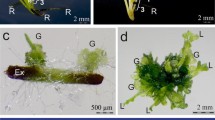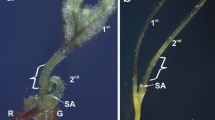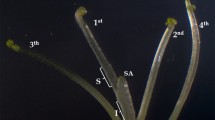Abstract
Somatic embryogenesis was initiated fromCephalotaxus harringtonia (Forbes) K. Koch embryo culture. Explants consisted of embryo and megagametophyte halves both cut longitudinally. They were removed aseptically from mature seeds and grown together on a solid Murashige and Skoog modified medium supplemented with 5 mg·l −1 2,4-dichlorophenoxyacetic acid. Embryogenic cultures started from callus after three or more months on the primary medium. The embryogenic callus originated from the suspensor region of the embryo. All chromosome counts made in the cells of the embryonic structures demonstrated a diploid stage, which suggest that they originated from zygotic embryo tissue. The early stages of somatic embryogenic development were achieved,i.e., formation of small clusters consisting of an embryonal region made up of isodiametric meristematic cells. A more advanced stage was reached in some cultures in which the distal embryonal end of the embryo appeared smooth and opaque. The ultrastructural characteristics of the embryos, the two types of embryo cells, embryonal and suspensor cells, as well as their contents were similar to those already reported in the case of somatic embryogenesis of other conifers.
Similar content being viewed by others
References
Becwar, M.R., Wann, S.R., Johnson, M.A., Verhagen, S.A., Feirer, R.P., and Nagmani, R. (1988) Development and characterization ofin vitro embryogenic systems in conifers.In Somatic cell genetics of woody plants. Ahuja, M.R. (ed.), 225pp, Kluwer Academic Publications, Dordrecht, 1–18.
Becwar, M.R., Nagmani, R., and Wann, S.R. (1990) Initiation of embryogenic cultures and somatic embryo development in Loblolly pine (Pinus taeda). Can. J. For. Res. 20:810–817.
Bourgin, J.P. and Nitsch, J.P. (1967) Obtention deNicotiana haploïdes à partir d'étamines cultivéesin vitro. Ann. Physiol. Vég. 9:377–382.
Chalupa, V. (1985) Somatic embryogenesis and plantlet regeneration from cultured immature and mature embryos ofPicea abies (L.). Kaerst. Commun. Inst. For. Cech. 14:57–63.
Feirer, R.P. (1988) Chloroplast ultrastructure and gene expression in embryogenic conifer callus.In Proceedings, 2nd IUFRO Working Party on Molecular Genetics, Petawawa National Forest Institute, Chalk River, Ontario, Canada, June 1987: Molecular genetics of forest trees. Cheliak, W.M. and Yapa, A.C. (eds.), Canadian Forestry Service Publications, Sault Ste. Marie, 895.
Gupta, P.K. and Durzan, D.J. (1986) Somatic polyembryogenesis from callus of mature sugar pine embryos. Bio./Tech. 4:643–645.
Hakman, I. (1993) Embryology in Norway spruce (Picea abies). An analysis of the composition of seed storage proteins and deposition of storage reserves during seed development and somatic embryogenesis. Physiol. Plant. 87:148–159.
Hakman, I. and Fowke, L.C. (1987) Somatic embryogenesis inPicea glauca (white spruce) andPicea mariana (black spruce). Can. J. Bot. 65:656–659.
Hakman, I., Fowke, L.C., von Arnold, S., and Eriksson, T. (1985) The development of somatic embryos in tissue cultures initiated from immature embryos ofPicea abies (Norway spruce). Plant Sci 38:53–59.
Hakman, I., Rennie, P., and Fowke, L.C. (1987) A light and electron microscope study ofPicea glauca (white sprcce) somatic embryos. Protoplasma 140:100–109.
Jasik, J., Salajova, T., and Salaj, J. (1995) Developmental anatomy and ultrastructure of early somatic embryos in European black pine (Pinus nigra Arn.). Protoplasma 185:205–211.
Klimaszewska, K. (1989) Plantlet development from immature zygowtic embryos of hybrid larch through somatic embryogenesis. Plant Sci. 63:95–104.
Murashige, T. and Skoog, F. (1962) A revised medium for rapid growth and bioassays with tobacco tissue culture. Physiol. Plant. 15:473–497.
Nagmani, R. and Bonga, J.M. (1985) Embryogenesis in subcultured callus ofLarix decidua. Can. J. For. Res. 15:1088–1091.
Profumo, P., Gastaldo, P., and Rascio, N. (1987) Ultrastructural study of different types of callus from leaf explants ofAesculus hippocastnum. Protoplasma 138:89–97.
Rohr, R. and Bonga, J.M. (1984) A method to isolate the female sexual cells ofLarix decidua for cytological studies. Can. J. Bot. 62: 1651–1658.
Rohr, R., von Aderkas, P., and Bonga, J.M. (1989) Ultrastructural changes in haploid embryoids ofLarix decidua during early embryogenesis. Am. J. Bot. 76: 1460–1467.
Salajova, T. and Salaj, J. (1992) Somatic embryogenesis in European black pine (Pinus nigra Arn.). Biol. Plant. 34: 213–218.
Tautorus, T.E., Fowke, L.C., and Dunstan, D.I. (1991) Somatic embryogenesis in conifers. Can. J. Bot. 69:1873–1899.
von Aderkas, P., Klimaszewska, K., and Bonga, J.M. (1990) Diploid and haploid embryogenesis inLarix leptolepis, L. decidua, and their reciprocal hybrids. Can. J. For. Res. 20:9–14.
Author information
Authors and Affiliations
About this article
Cite this article
Rohr, R., Piola, F. & Pasquier, P. Somatic embryogenesis inCephalotaxus harringtonia embryo-megagametophyte co-culture. J. For. Res. 2, 69–73 (1997). https://doi.org/10.1007/BF02348471
Accepted:
Issue Date:
DOI: https://doi.org/10.1007/BF02348471




